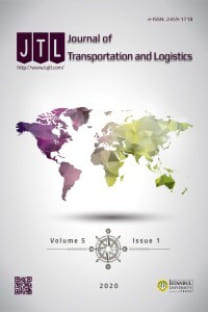İç Liman-Liman Sistem Geliştirme: Ürün Yaşam Döngüsü Uygulaması
İç Liman, Liman, Multimodal Taşımacılık, Ürün Yaşam Döngüsü Teorisi, Tedarik Zinciri Yönetimi
Dry port-seaport system development: Application of the product life cycle theory
Dry port, Sea port, Multimodal, transport Product life cycle theory, Supply chain management,
___
- Andersson, D., & Roso, V. (2016). Developing Dry Ports Through the Use of Value-Added Services. In Commercial Transport (191-203). Springer International Publishing.
- Barnard B (2007) Freight transport coursework. Journal of Commerce (New York)
- Bask, A., Roso, V., Andersson, D., & Hämäläinen, E. (2014). Development of seaport–dry port dyads: two cases from Northern Europe. Journal of Transport Geography, 39, 85-95.
- Bask, A; V. Roso, D. Andersson, E. Hämäläinen, (2014); Development of seaport–dry port dyads: two cases from Northern Europe; Journal of Transport Geo 39 (2014) 85–95.
- Benabbou L., N. Sbihi et S. K. (2012). Optimisation du traitement des conteneurs au niveau d’une plateforme ferroviaire, 1st International IEEE Conference on Logistics Operations Management ISEL (Institut Supérieur des Etudes Logistiques),
- Bentaleb, F. Mabrouki, C. SemmaA., (2016), Dry Port Location Problem: A Hybrid Multi-Criteria Approach, Journal of ETA Maritime Science, Volume 4, Issue 1, Pages 73 - 90,
- Bentaleb, F. Mabrouki, C. SemmaA., (2015a), Dry Port Development: A Systematic Review, Journal of ETA Maritime Science, Volume 3, Issue 1, Pages 75 - 96,
- Bentaleb, F. Mabrouki, C. SemmaA., (2015b), Key Performance Indicators Evaluation and Performance Measurement in Dry Port-Seaport System: A Multi Criteria Approach, Journal of ETA Maritime Science, Volume 3, Issue 1, Pages 97 -116,
- Bentaleb, F. Mabrouki, C. SemmaA., (2015c). A Multi-Criteria Approach for Risk Assessment of Dry Port-Seaport System. Supply Chain Forum: An International Journal, Volume 16, Issue 4, pages 32-49.
- Beresford, A., Pettit, S., Xu, Q., & Williams, S. (2012). A study of dry port development in China. Maritime Economics & Logistics, 14(1), 73-98.
- Bergqvist, R., Wilmsmeier, G., (2009). Extending the role and concept of dryports: A response to the public consultation of ‘‘A Sustainable Future for Transport: Towards an Integrated, Technology-led and User Friendly System. Dryport Project.
- Black, J., Kyu, T., Roso, V., & Tara, K. (2013). Critical evaluation of Mandalay dry port, Myanmar. In Proceedings 5th International Conference on Logistics and Transport 2013 (ICLT 2013)" Sustainable Supply Chain Management in Asia Pacific", November 5-8, 2013, Doshisha University, Kyoto, Japan (pp. 107-114).
- Caballini, C., & Gattorna, E. (2009). The expansion of the port of Genoa: the Rivalta Scrivia dry port. Development of Dry Ports, 73.
- Cezar-Gabriel, C., & Sebastian, P. (2012). Managing Risks in Dry Port Operations. Ovidius University Annals, Economic Sciences Series, 12(1), 851-855.
- Chang, Z., and T. Notteboom. "Location analysis of dry ports using fuzzy c-means (FCM) clustering. A case study of the port of Dalian." WCTR, 2012.
- Chang, Z., Notteboom, T., & Lu, J. (2015). A two-phase model for dry port location with an application to the port of Dalian in China. Transportation Planning and Technology, 38(4), 442-464.
- Chang-zheng, Z. H. U. (2011). Study on International Dry Port Collaboration Mechanism. Logistics Technology, 15, 009.
- Yayın Aralığı: 2
- Başlangıç: 2015
- Yayıncı: İstanbul Üniversitesi
İç Liman-Liman Sistem Geliştirme: Ürün Yaşam Döngüsü Uygulaması
Bentaleb FATİMAZAHRA, Mouhsene FRİ, Charif MABROUKİ, Alami SEMMA
Nijerya’daki İmalat Firmalarının Örgütsel Performans ve Elektrik Hizmet Kalitesi Algıları
Abdulrahman MUHAMMED, Lamidi YUSUF
Furkan YENER, Harun Reşit YAZGAN, Serap ERCAN CÖMERT, Sena KIR, Yağmur KAYA
